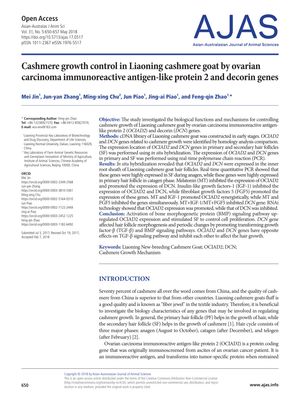Cashmere Growth Control in Liaoning Cashmere Goat by Ovarian Carcinoma Immunoreactive Antigen-Like Protein 2 and Decorin Genes
March 2018
in “
Asian-Australasian journal of animal sciences
”
ovarian carcinoma immunoreactive antigen-like protein 2 OCIAD2 decorin DCN inner root sheath hair follicles secondary follicles anagen phase primary follicles catagen phase melatonin MT insulin-like growth factors-1 IGF-1 fibroblast growth factors 5 FGF5 RNA interference RNAi bone morphogenetic protein BMP signaling pathway TGF-β signaling pathway hair follicle morphogenesis BMP TGF-β

TLDR OCIAD2 and DCN genes affect hair growth in goats by having opposite effects on a growth signaling pathway and inhibiting each other.
The study explored the roles of ovarian carcinoma immunoreactive antigen-like protein 2 (OCIAD2) and decorin (DCN) genes in regulating cashmere growth in Liaoning cashmere goats. It was found that OCIAD2 and DCN are expressed in the inner root sheath of hair follicles, with high expression in secondary follicles during the anagen (growth) phase and in primary follicles during the catagen (regression) phase. Melatonin (MT) was observed to inhibit OCIAD2 expression while promoting DCN expression, whereas insulin-like growth factors-1 (IGF-1) inhibited both OCIAD2 and DCN expression. Conversely, fibroblast growth factors 5 (FGF5) increased the expression of these genes. The study also found that MT and IGF-1 could work together to promote OCIAD2 expression, while MT and FGF5 could inhibit it. Additionally, RNA interference (RNAi) technology indicated that increasing OCIAD2 expression could inhibit DCN. The activation of the bone morphogenetic protein (BMP) signaling pathway was found to up-regulate OCIAD2 expression and stimulate secondary follicles, while DCN influenced hair follicle morphogenesis and periodic changes by promoting TGF-β and BMP signaling pathways. The study concluded that OCIAD2 and DCN genes have opposite effects on the TGF-β signaling pathway and inhibit each other, impacting hair growth.






